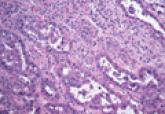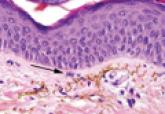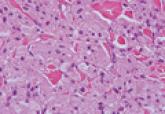Dermpath Diagnosis

Pseudoglandular Squamous Cell Carcinoma
Squamous cell carcinoma (SCC) is the second most common form of skin cancer. Pseudoglandular SCC presents most often on sun-damaged skin of...
Puja K. Puri, MD
From the Department of Pathology, Laboratory Corporation of America, Research Triangle Park, North Carolina, and the Department of Pathology, Duke University Medical Center, Durham, North Carolina.
The author reports no conflict of interest.
Correspondence: Puja K. Puri, MD, Laboratory Corporation of America Center for Molecular Biology and Pathology, 1912 TW Alexander Dr, Research Triangle Park, NC 27709 (purip@labcorp.com).

The larvae of Onchocerca volvulus, a nematode that is most commonly found in tropical Africa, Yemen, Central America, and South America, are transmitted by flies of the genus Simulium that breed near fast-flowing rivers. The flies bite the host and transmit the larvae, and the larvae then mature into adults within the skin and subcutis, forming nodules that typically are not painful. The worms may reside within the skin for years and produce microfilariae, which can migrate and cause visual impairment, blindness, or a pruritic papular rash.
The differential diagnosis for onchocerciasis includes dirofilariasis, myiasis, scabies, and tungiasis.
The larvae of Onchocerca volvulus, a nematode that is most commonly found in tropical Africa, Yemen, Central America, and South America, are transmitted by flies of the genus Simulium that breed near fast-flowing rivers.1 The flies bite the host and transmit the larvae, and the larvae then mature into adults within the skin and subcutis, forming nodules that typically are not painful. The worms may reside within the skin for years and produce microfilariae, which can migrate and cause visual impairment, blindness, or a pruritic papular rash.1
The nematode produces a nodule within the dermis or subcutis with surrounding fibrous tissue and a mixed inflammatory infiltrate with eosinophils (Figure 1). In some cases, microfilariae can be seen within the lymphatics or within the uteri of the worms.1 Male and female worms typically are present and have a corrugated cuticle with a thin underlying layer of striated muscle. The females have paired uteri, which usually contain microfilariae2 (Figure 2).
| Figure 1. Cross-section of a nematode with surrounding inflammatory reaction, characteristic of onchocerciasis (H&E, original magnification ×20). | Figure 2. Onchocerca volvulus with a cuticle, underlying thin layer of muscle, and paired uteri containing microfilariae (H&E, original magnification ×100). |
Dirofilaria repens also is a nematode that produces a subcutaneous nodule with an inflammatory reaction. This worm typically has a thick cuticle with longitudinal ridges, long thick muscle, and lateral cords.3 Additionally, because humans are not the usual host, Dirofilaria species do not complete their lifecycle and typically are not gravid, unlike Onchocerca species.
Myiasis is the presence of fly larvae within the skin. The larvae demonstrate a thick hyaline cuticle with pigmented brown-yellow spikes (Figure 3). There is a thick muscular layer under the cuticle and a tubular tracheal system containing vertical striations. The digestive system has an epithelial lining with prominent vessels. Adipose tissue with granulated cytoplasm, prominent nuclei, and coarse chromatin also are present.4
Scabies mites (Figure 4), ova, and scybala are present within the stratum corneum. A mixed inflammatory infiltrate also can be present.1 Tungiasis is caused by burrowing fleas and typically occurs on acral skin; therefore, it is more frequently found in the superficial portion of the skin. Erythrocytes usually are present in the gastrointestinal tract, and the females usually are gravid.2 A surrounding mixed inflammatory infiltrate is present, and necrosis also can occur (Figure 5).1
| Figure 4. Scabies mites within the stratum corneum (H&E, original magnification ×100). | Figure 5. Tunga penetrans at the surface of acral skin. Erythrocytes can be noted within the gastrointestinal tract (H&E, original magnification ×40). |

Squamous cell carcinoma (SCC) is the second most common form of skin cancer. Pseudoglandular SCC presents most often on sun-damaged skin of...

Localized cutaneous argyria often presents as asymptomatic black or blue-gray pigmented macules in areas of the skin exposed to silver-containing...

Granular cell tumors (GCTs) tend to present as solitary nodules, not uncommonly affecting the dorsum of the tongue but also involving the skin,...
